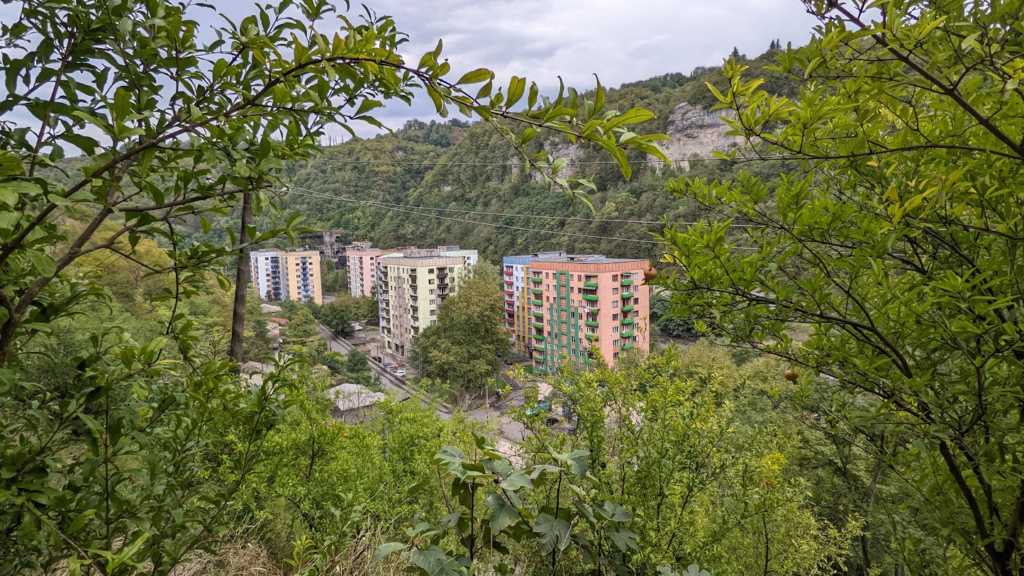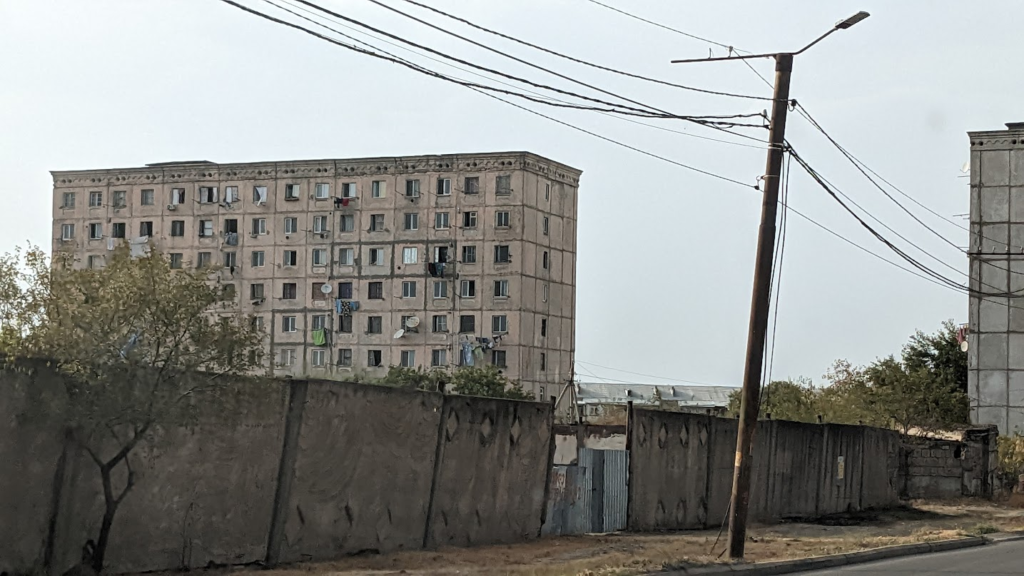The capital cities of Baku, Tbilisi, and Yerevan are also their countries’ largest cities, and that’s where I spent most of my time. But I visited several smaller cities and towns in the Caucasus, a few on overnights, and others on short day trips or drive-throughs.
A few of these had some charm, with attractive older buildings and pleasant streets to wander through. Others were mostly without interest, other than a particular site of historical importance. And some were eerily trapped in a Soviet time warp, with blocky apartment buildings and nothing remotely attractive. But these places had their own historical interest for me. Remembering how people lived in Soviet times is essential to understanding how we must learn from history’s mistakes.
About this post
I normally try to blog as I go, but during the last part of my time in the Caucasus, I was on the go so much that I didn’t find time to post updates.
I also try to chronicle my daily activities while traveling. But instead, now that I’ve been home a few weeks, I’m offering a series of posts to summarize some of the things I learned and experienced while I was in Azerbaijan, Georgia, and Armenia.
The Pretty
There are several lovely places that top my list of the prettiest towns I visited. None of these comes close to matching the quaint charm of places like the hilltowns of Tuscany or the quaint villages north of Amsterdam. The places I visited in the Caucasus weren’t “cute.” But it wasn’t in any way disappointing. I didn’t go to the Caucasus to see the same kinds of places I’ve already seen in countries all over Europe. I went to see things that are different. And it was different. Not lesser, just different.
Shaki, Azerbaijan
I spent one night in Shaki. The main attraction there, without question, is the Palace of the Shaki Khans, one of the most beautiful palaces I’ve ever visited. But I had time to walk around the town a bit, and it definitely has its charms.

Sighnaghi, Georgia
Mtskheta, Georgia
This town benefits from its setting at the confluence of the Mtkvari and Aragvi Rivers. And though I didn’t spend a lot of time there, what I saw was delightful cobbled streets lined with nice houses and shops.
Gyumri, Armenia
Another town where I didn’t have nearly enough time, Gyumri is the second largest city in Armenia. With a population of just over 100,000 and a pleasant center with a grand plaza, Gyumri doesn’t feel very urban.
On December 7, 1988, a devastating earthquake caused severe damage to Gyumri (then called Leninakan). Prior to the earthquake, the population was over 200,000, but so many buildings were destroyed or severely damaged that many were forced to move elsewhere. There is still plenty of evidence of the devastation.
Unfortunately, the walking tour I got was very brief. Davit seemed to have no idea where to go or what to show me. He took me into a Soviet-era barbershop, and we walked through Vartanants Square. I would have loved a few hours to explore, but that didn’t happen. Still, I count Gyumri among the prettiest smaller cities I visited in the Caucasus.

The Almost Pretty
Several of the places I visited fall into this category. These are places with some attractive qualities, but some things that detract from the overall delights.
Guba, Azerbaijan
We drove through the main part of Guba (on the way to Khinalig) so quickly that I really can’t say if it was prettier than what I saw from the car.
On the way back, we stopped in Gyrmyzy Gasaba (“Red Town”) a community across the Qudyalchay River from the main part of the town. This community is widely believed to be the world’s only population center outside Israel or the USA that is made up exclusively of Jewish people, and is considered to be the last surviving shtetl. The Jews who live there are descendants of Jews who migrated from ancient Israel to Persia in the 8th century BCE, and then to the Caucasus Mountains between the 5th century BCE and the 7th century CE. They resettled from their mountain villages to Guba and other cities in the 18th and 19th centuries.
The Red Town had some attractive buildings, but other than the synagogue, I didn’t have a chance to explore. Here is a sample from Wikipedia of some of the buildings in Guba and Gyrmyzy Gasaba.

Chiatura, Georgia
Chiatura, a former mining town with a system of Soviet-era cable cars once used to bring workers to the mines, also has a stunnning monastery built into a cave. The setting, in a valley surrounded by steep cliffs, is stunning. This could be a beautiful place to visit, but the town itself is nondescript at best, with plenty of unattractive buildings.


Kutaisi, Georgia
Kutaisi is the third largest city in Georgia. So while it has some pretty areas and lovely buildings, it also has much that is just ordinary. I had two full days there. The first included a walking tour of the city as well as several nearby religious sites. I was hoping to spend the second day visiting several nature places in the vicinity. But when the rain forced the cancelation of those plans, I had to spend the day walking around Kutaisi again. I ran out of interesting things to see fairly quickly.
Akhaltsikhe, Georgia
The other place I stayed two nights, Akhaltsikhe, was dominated by its beautiful fortress and otherwise was rather ordinary.
The Rest
In a way, some of the most unattractive towns were the most interesting. I in no way want to disparage those cute eye-candy villages like Ærøskøbing, Denmark, or Trogir, Croatia. Nor all the ruins of ancient cities I saw in Turkey that have been reconstructed to “more-or-less” show us how they once looked and how the people lived. But there was something special about seeing some of the uglier places I visited on this trip. When the history is very recent, seeing it strikes a chord with me. There are people still alive who remember when these places were new, when they gleamed. There are people who have lived through the years since then and have seen how time and neglect have changed these places.
Tskaltubo, Georgia
I had a fantastically surreal experience visiting Tskaltubo, which I already wrote about. It is filled with decaying spa-hotels but still has a few that are operational, attracting a small number of visitors for the radon-carbonate mineral springs, and there are plans to restore the town to its former glory. I didn’t really see much of the town other than the remains of the resorts Irakli took me to. I’ve read that there is much in Tskaltubo that makes it worth visiting other than out of curiosity.
Rustavi, Georgia
Rustavi provided a fascinating look back at a place that has not moved on from its days as a polluted center of manufacturing in the Soviet era. It is probably the ugliest city I saw on this trip.
Khinalig
The other town that is really etched in my memory is Khinalig, which I wrote a little about in my post from Azerbaijan. I can’t list Khinalig with the other places. It is unique.
This tiny village is the highest and most isolated village in Azerbaijan, one of the highest in all of the Caucasus. Because it is so remote, it has retained the same general character for centuries. The houses are built of stone and have minimal furniture, but many pillows, blankets, and mattresses. They collect cow dung for heating their homes. They also raise sheep and goats, and I saw lots of chickens in the streets and yards. The people engage in weaving and in the collection of herbs and the cultivation of honey. They speak a distinct language, although many also speak Azerbaijani.
There is nothing of note to see in Khinalig. It’s not a pretty town. And it took a long time to get there (though the scenery was magnificent). But I’m so glad I got to see this place.
There are plans to improve the road to Khinalig and to improve the local infrastructure in order to attract more tourists. In 2008 the village was listed by the World Monuments Fund as one of the world’s most endanged sites. Here’s what they say about it:
Located at an elevation of 2,300 meters in the Caucasus Mountains, the village of Khinalyg is known for its garadams, or traditionally built houses. Built of river stones, these single-room structures have flat roofs and an aperture to let in light and allow smoke to escape. The garadams blend into the mountains in which the village is nestled, and the houses are built so close to each other that there are no streets or yards separating them. Rather, the roofs of the houses on lower levels act as the yards for the houses above. According to village elders, there were originally four different tribes within the village, each living within its own quarter and speaking variations of the Khinalyg language. Although archaeological findings suggest that the village has been occupied for two millennia, the remains we see today date to the seventeenth to nineteenth centuries. Recent construction of a road between Khinalyg and Guga, the local district headquarters, is changing the nature of this once-isolated village, with easier access expected to attract tourists and commercial activity to Khinalyg. Although tourism and development would be welcome—and would provide new sources of revenue for the village—there is concern about preserving Khinalyg’s unique character. It is hoped that inclusion on the Watch List will help Khinalyg allow for expansion and better communication with the outside world, but not at the expense of its essential character.
https://www.wmf.org/project/khinalyg-village
In the photos below it is clear that some modern materials are being used for the roofs of the homes in Khinalig. Ramin told me that the government is going to require these to be replaced with more traditional materials.
Here are all my photos of these places:























Tammy
How was the food?
Lane
Tammy, I am working on a post about the food. Stay tuned!